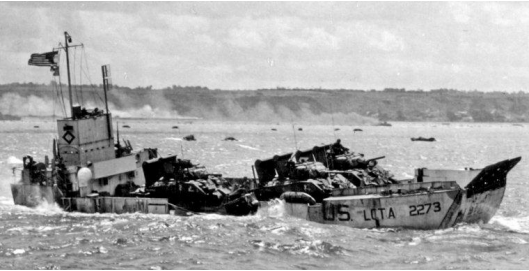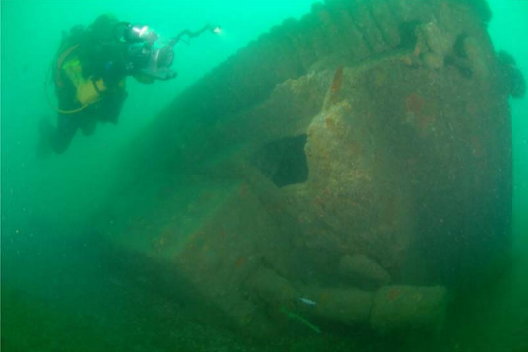
Our Landing Craft Project was funded by English Heritage through the Historic Environment Enabling Program. The project enabled collaborative work between the Trust and Southsea Sub-Aqua Club (SSAC) to survey and record the remains of LCT(A) 2428, a Second World War landing craft that sank in the eastern Solent in June 1944, leaving remains spread across two sites. The project developed the work already carried out by SSAC. Diving on the two sites was conducted during the summer of 2010 and the final report is available for download.
The investigation of the landing craft and its former cargo was not just confined to survey by maritime archaeologists. An oral history project was also undertaken which helped us gather more information about the type of landing craft, their use, life on board and the sinking of LCT(A) 2428. Some of the information from the oral history project is available for download as a podcast.
As well as providing an opportunity to study a vessel type that was very important in the recent history of the UK, the landing craft project was also used as a case-study for the protection of English underwater archaeology, specifically shipwrecks, using the same legislation that is applied to sites on land. The landing craft project therefore had a much wider significance for the long-term preservation and management of shipwreck sites around the coast of England.
Vessel Background
The Mark V Landing Craft Tank (LCT) 2428 was originally delivered to the UK from the USA under the lend-lease program. In early 1944, in preparation for the Allied invasion of Europe, the vessel was fitted with armour plating and was re-designated as Landing Craft Tank (Armoured) 2428 (or LCT(A) 2428). LCT(A) landing craft were intended to carry two or three tanks that would provide heavy firepower support, both during the run in to the beach, and then after dis-embarkment. The landing craft also carried armoured bulldozers to clear beach obstacles. LCT(A) 2428 was the ‘leader’ of the 105th Flotilla of Assault Group J1 Support Squadron, assigned to Juno beach to support the 7th Infantry of the 3rd Canadian Division at Courseulles-sur-Mer.
The tanks carried by LCT(A) 2428 were Centaur CS IV tanks. These tanks were used exclusively by the Royal Marines Armoured Support Group and were built at the Horwich Locomotive Works, Greater Manchester. The Caterpillar D7 armoured bulldozers were used by the British Army’s 79th Armoured Division and the Royal Engineers. With such heavy equipment on board, in addition to its extra armour plating, the landing craft would have been very heavily loaded. The lack of freeboard (the distance between the surface of the sea and the topside of the vessel) for the channel crossing has been noted by other LCT(A) commanders.
On the evening of the 5th June 1944, while on passage to Normandy, LCT(A) 2428 experienced engine trouble. Although taken under tow by the rescue tug HMS Jaunty, the landing craft capsized and lost its cargo. HMS Jaunty fired upon the upturned hull until it sank, in order to remove a potential navigational hazard for other vessels in the invasion fleet. None of the crew of LCT(A) 2428 were lost.
Site Overview
The manner of loss of LCT(A) 2428 created two sites on the seabed. The first site, at the point of capsize, consists of the vehicles and other equipment that was being carried on board at the time. The second site comprises the upturned hull of the landing craft.
In 2008, Southsea Sub-Aqua Club (SSAC) began to investigate an unusual dive site that consisted of the remains of two tanks, two armoured bulldozers, a possible jeep and other military equipment. This was the cargo of LCT(A) 2428, still preserved on the seafloor over sixty years after the capsize. Further investigation by SSAC located the hull of the vessel around 6km to the east of the vehicle site. SSAC undertook further investigation of the vehicle site under the guidance of the Nautical Archaeology Society (NAS) ‘Adopt-a-Wreck’ scheme.
In July 2010 two Maritime Archaeology Trust dive teams, joined by Martin Davies and Jim Fuller from SSAC, visited both sites as part of the Eastern Solent Marine Archaeology Project 2010.

The hull section of LCT(A) 2428 is scattered across a large area, as would be expected of a vessel approximately 37m in length. Divers observed ‘goal-post’-like upright elements that represent the hull and deck beam supports of the original vessel, as well as an extensive engine block arrangement including a propeller and shaft. There appeared to be two main concentrations of wreckage with other significant material distributed across a wider area of seabed.
Further to the west, a cluster of armoured vehicles lie on the seabed in much the same arrangement as they would have been parked on the open deck aboard LCT(A) 2428. SSAC divers have produced measured plans of this assemblage, including two Centaur CS IV tanks laying side by side, with two D7 armoured bulldozers immediately to the south. The remains of another vehicle, possibly a Willys Jeep, are present to the north, amongst a dense distribution of High Explosive (HE) ammunition.
Further work was conducted in September 2010, including a detailed survey of the vehicles themselves to produce a three-dimensional site plan. The establishment of monitoring points was completed, and this, with the fixed location of the wreck features, enables an understanding of the relative stability of the sites, which will inform an assessment of the potential benefits of statutory heritage protection.
You may also be interested in the Solent 70 project.
